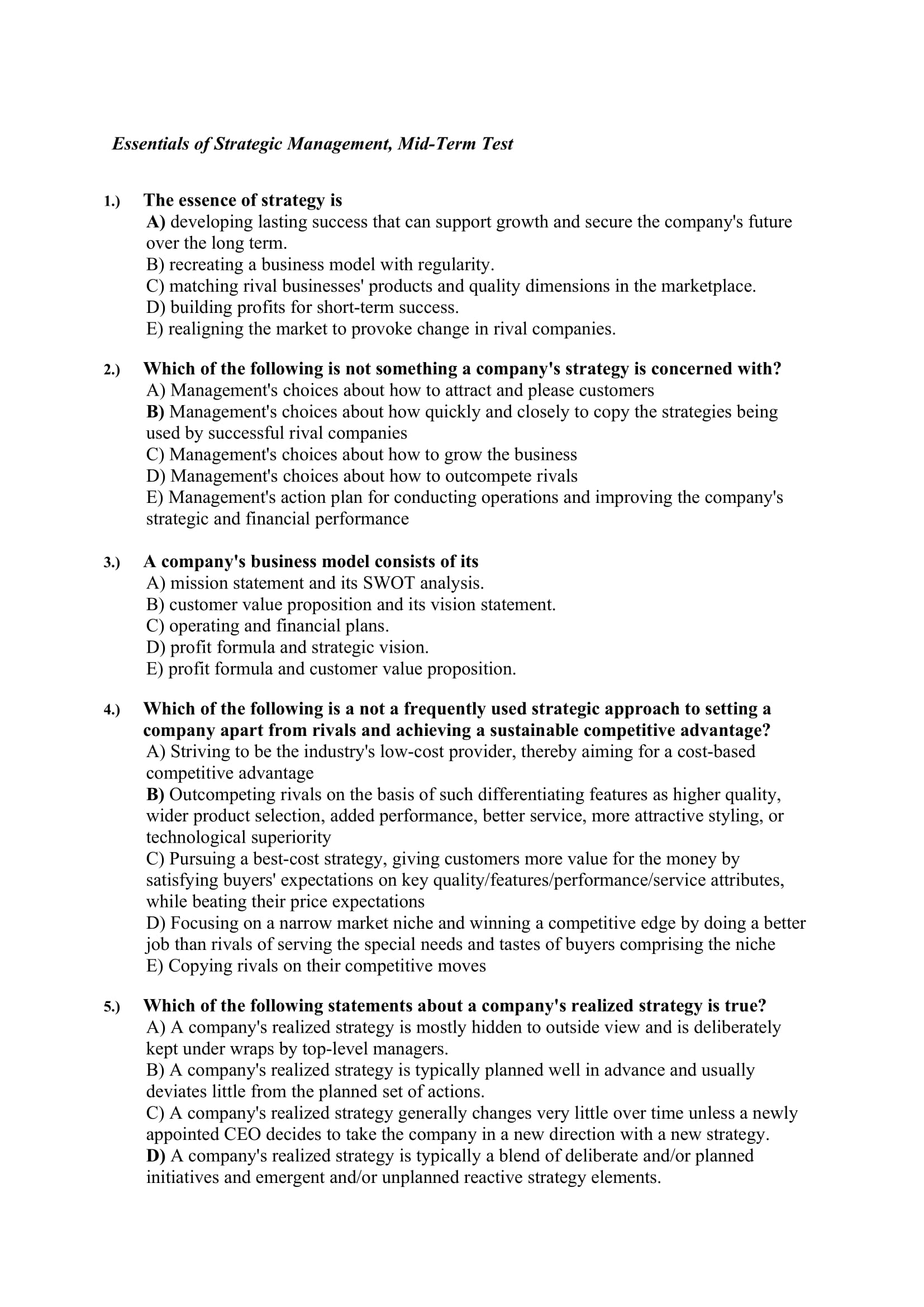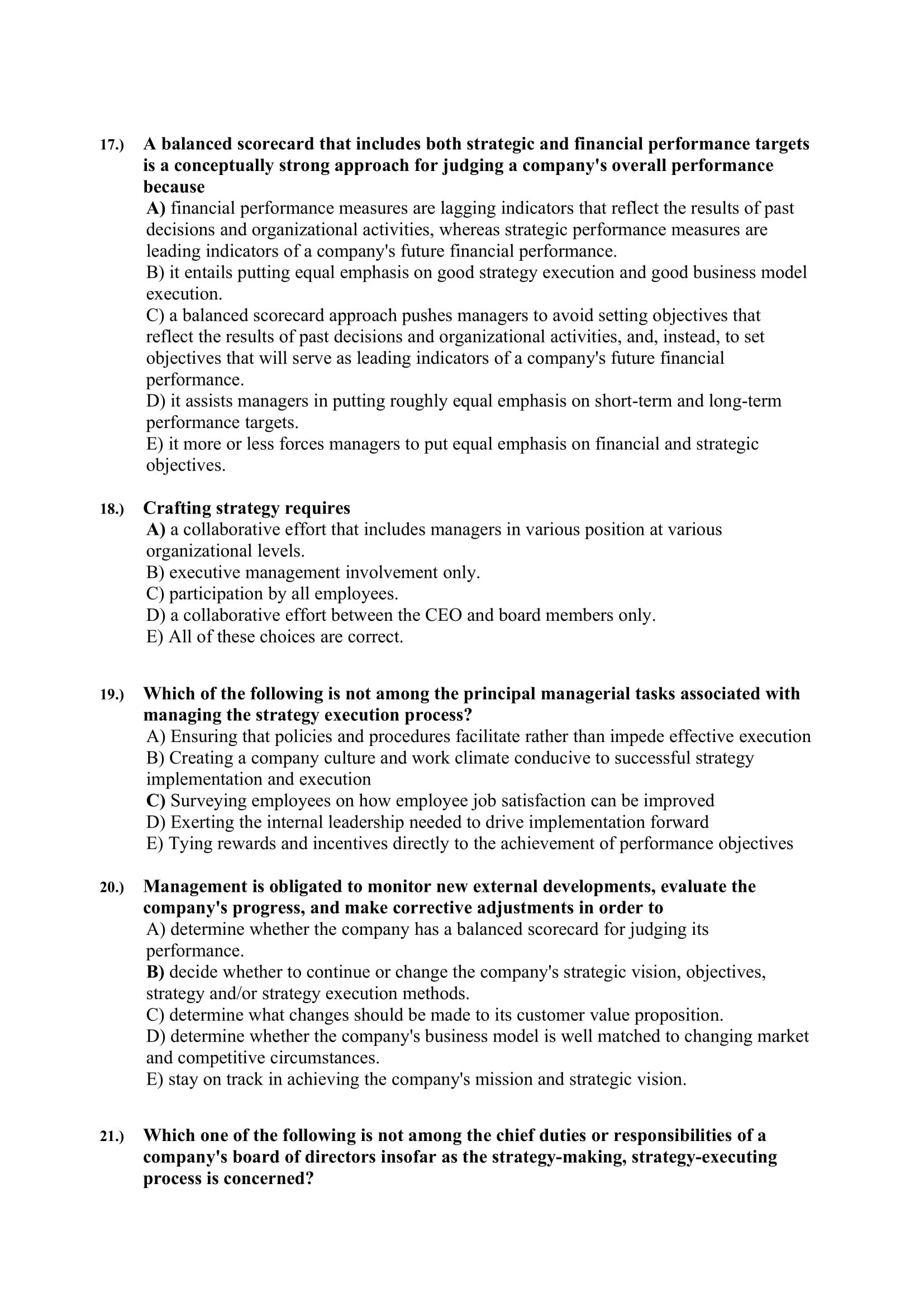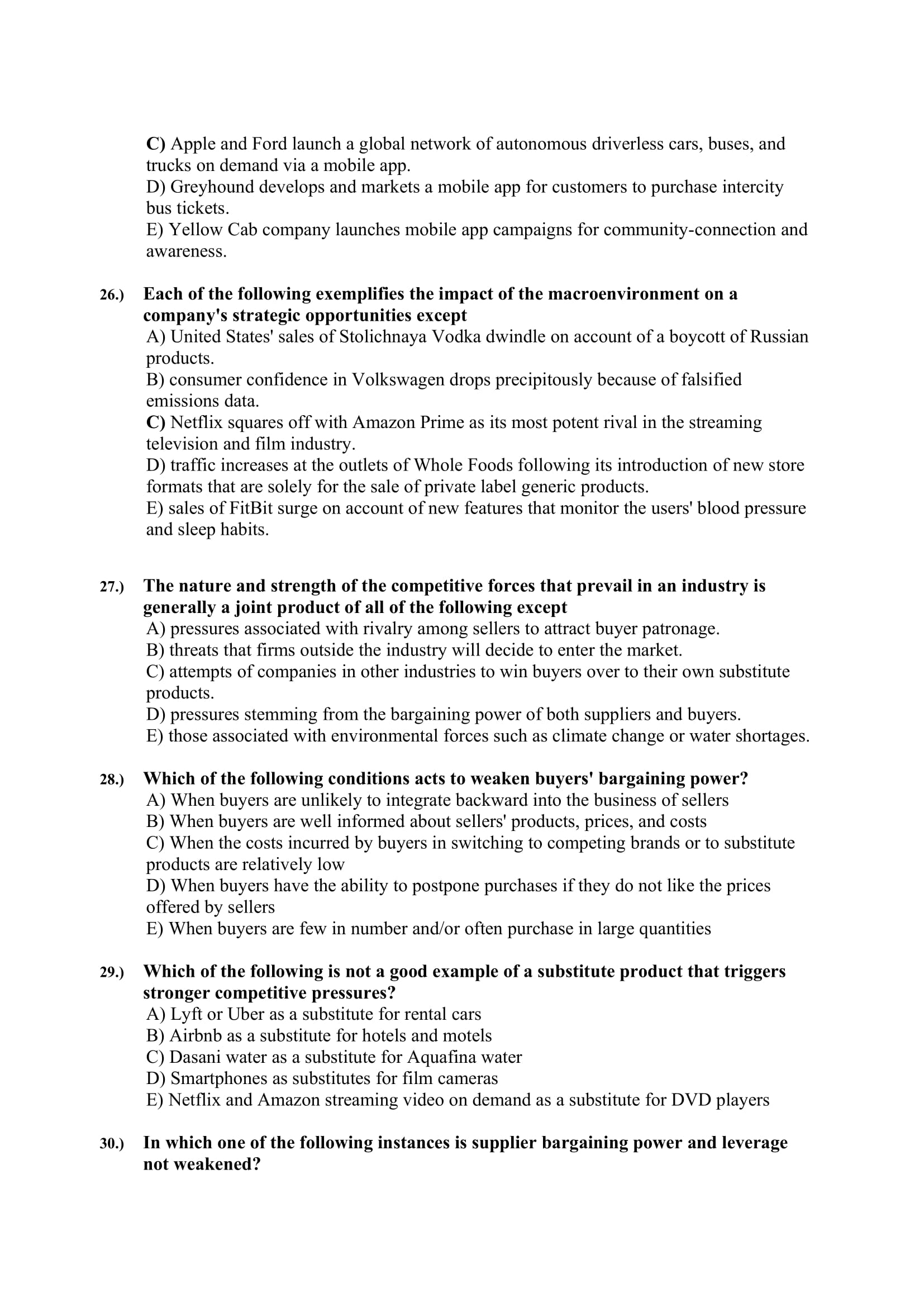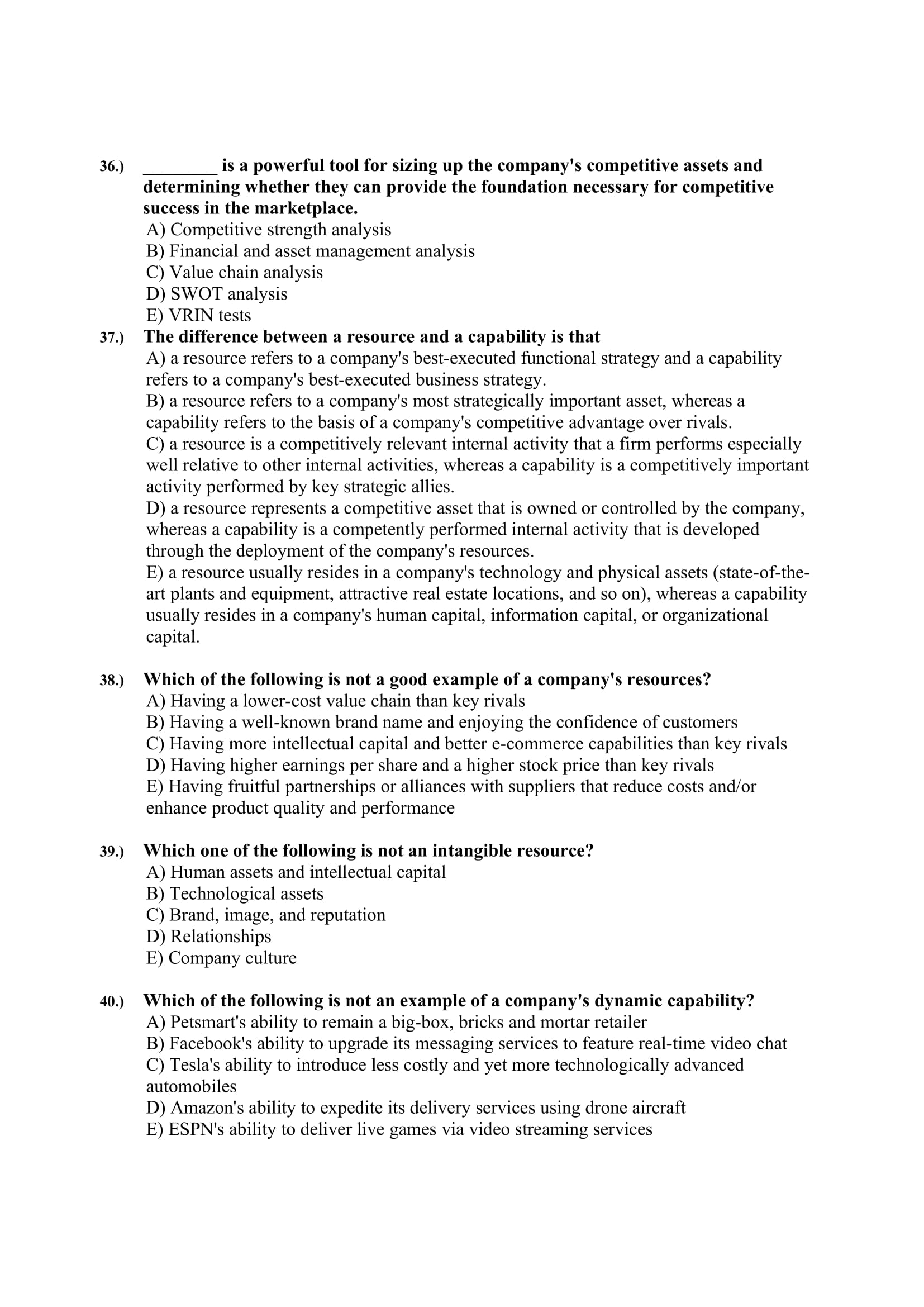answer following questions
Essentials of Strategic Management, Mid Term Test 1.) The essence of strategy is A) developing lasting success that can support growth and secure the company's future over the long term. B) recreating a business model with regularity. C) matching rival businesses' products and quality dimensions in the marketplace. D) building prots for short-term success. E) realigning the market to provoke change in rival companies. 2.) Which of the following is not something a company's strategy is concerned with? A) Management's choices about how to attract and please customers B) Management's choices abOut how quickly and closely to copy the strategies being used by successful rival companies C) Management's choices about how to grow the business D) Management's choices about how to outcompete rivals E) Management's action plan for conducting operations and improving the company's strategic and nancial performance 3.) A company's business model consists of its A) mission statement and its SWOT analysis. B) customer value proposition and its vision statement. C) operating and nancial plans. D) prot formula and strategic vision. E) prot formula and customer value proposition. 4.) Which of the following is a not a frequently used strategic approach to setting a company apart from rivals and achieving a sustainable competitive advantage? A) Striving to be the industry's low-cost provider, thereby aiming for a cost-based competitive advantage B) Outcompeting rivals on the basis of such differentiating features as higher quality, wider product selection, added performance, better service, more attractive styling, or technological superiority C) Pursuing a best-cost strategy, giving customers more value for the money by satisfying buyers' expectations on key quality/features/performance/service attributes, while beating their price expectations D) Focusing on a narrow market niche and winning a competitive edge by doing a better job than rivals of serving the special needs and tastes of buyers comprising the niche E) Copying rivals on their competitive moves 5.) Which of the following statements about a company's realized strategy is true? A) A company's realized strategy is mostly hidden to outside view and is deliberately kept under wraps by top-level managers. B) A company's realized strategy is typically planned well in advance and usually deviates little from the planned set of actions. C) A company's realized strategy generally changes very little over time unless a newly appointed CEO decides to take the company in a new direction with a new strategy. D) A company's realized strategy is typically a blend of deliberate and/or planned initiatives and emergent andfor unplanned reactive strategy elements. E) A company's realized strategy is developed mostly on the y because of the constant efforts of managers to keep rival companies at a disadvantage. 6.) Consider the following three companies and their strategies: Company A is an established database management company that acquires a well~reputed but small publishing house to enter the booming publishing industry. Company B, a sports management house, declared bankruptcy during a recent recession but now has created a television network that airs regional sports events. Company C, a package delivery business, is a startup based on delivery efciency models created by a few students and delivers almost all kinds of packages. Which of the following describes the use of strategies by these companies accurately? A) Company B employs an emergent strategy, whereas companies A and C employ deliberate strategies. B) All three companies employ deliberate strategies. C) All three companies employ emergent strategies. D) Company C employs a deliberate strategy, whereas companies A and B employ emergent strategy. E) Companies A and C employ emergent strategies, whereas Company B employs a deliberate strategy, 7.) Which one of the following is not one of the ve stages of an ongoing, continuous strategic management process? A) Developing a strategic vision of what the company's future direction and focus needs to be B) Developing a sustainable business model C) Crafting a strategy to advance the company along the path that management has charted and achieve its performance objectives D) Setting objectives to measure progress toward achieving the strategic vision E) Executing the chosen strategy efciently and effectively 8.) The strategic management process is shaped by A) management's strategic vision, strategic and nancial objectives, and strategy. B) the decisions made by the compensation and audit committees of the board of directors. C) external factors such as the industry's economic and competitive conditions and internal factors such as the company's collection of resources and capabilities. D) a company's customer value proposition and prot formula. E) actions to strengthen competitive capabilities and correct weaknesses, actions to strengthen market standing and competitiveness by acquiring or merging with other companies, and actions to enter new geographic or product markets. 9.) When a company is confronted with signicant industry change that mandates radical revision of its strategic course, the company is said to have encountered a(n) A) learning and growth perspective. B) strategic inection point. C) strategic roadblock. D) new strategic opportunity. E) opportunity for corporate entrepreneurship. 10.) Which one of the following is not an accurate attribute of an organization's strategic vision? A) Providing a clearly articulated view of "where we are going" B) Describing the company's future productcustomermarkettechnology focus C) Pointing an organization in a particular direction and charting a strategic path for it to follow D) Providing managers with a reference point for making strategic decisions E) Specifying how the company intends to implement and execute its business model 11.) Which one of the following is not a characteristic of an effectively worded strategic vision statement? A) Directional (is forwardlooking, describes the strategic course that management has charted and the kinds of productmarket-customer-technology changes that will help the company prepare for the future) B) Easy to communicate (is explainable in 10 to 15 minutes, can be reduced to a memorable slogan) C) Graphic (paints a picture of the kind of company management is trying to create and the market position or positions the company is striving to stake out) D) Consensus-driven (commits the company to a "mainstream" directional path that most stakeholders will enthusiastically support) E) Focused (is specic enough to provide guidance to managers in making decisions and allocating resources) 12.) Effectively communicating the strategic vision down the line to lower-level managers and employees has the value of A) not only explaining "where we are going and why" but, more importantly, also inspiring and energizing company personnel to unite to get the company moving in the intended direction. B) helping company personnel understand why making a prot is so important. C) making it easier for top executives to set strategic objectives. D) helping lower-level managers and employees better understand the company's business model. E) All of these choices are correct. 13.) A company's mission statement typically addresses which of the following questions? A) Who are we, what do we do, and why are we here? B) What objectives and level of performance do we want to achieve? C) Where are we going, and what should our strategy be? D) What approach should we take to achieve sustainable competitive advantage? E) Why have we chosen a particular business model to achieve our objectives and our vision? 14.) The difference between the concept of a company mission statement and the concept of a strategic vision is that A) a mission statement typically concerns a company's present business scope ("who we are and what we do"), whereas the principal concern of a strategic vision is with the company's future business scope (longterrn direction and future product-customer~ markettechnology focus). B) the mission is to make a prot, whereas a strategic vision concerns how to attract customers. C) a mission statement deals with what to accomplish on behalf of shareholders and a strategic vision concerns what to accomplish on behalf of customers. D) a mission statement concerns what to do to achieve shortrun objectives and a strategic vision concerns what to do to achieve longrun performance targets. E) a mission statement deals with "where we are headed," whereas a strategic vision provides the critical answer to "how will we get there." 15.) A company's core values typically do not include such things as A) entrepreneurial spirit, excellent customer service, and building shareholder value. B) giving back to the community, doing the right thing, and entrepreneurial spirit. C) fair treatment, integrity, ethical behavior, innovativeness, and teamwork. D) topnotch quality, superior customer service, social responsibility, and community citizenship. E) minimizing innovation, rewarding individuality, and setting nancial performance targets. 16.) The primary managerial purpose of setting objectives is to A) ensure that deliberately vague language such as \"reducing costs" and "becoming more efcient" is used to provide managers with more latitude in setting stretch objectives for the company. B) designate strategic outcomes as lagging indicators. C) balance the scorecard of nancial and strategic objectives. D) designate nancial outcomes as leading indicators. E) convert the strategic vision into specic performance targets. 17.) 18.) 19.) 20.) 21.) A balanced scorecard that includes both strategic and nancial performance targets is a conceptually strong approach for judging a company's overall performance because A) nancial performance measures are lagging indicators that reect the results of past decisions and organizational activities, whereas strategic performance measures are leading indicators of a company's future nancial performance. B) it entails putting equal emphasis on good strategy execution and good business model execution. C) a balanced scorecard approach pushes managers to avoid setting objectives that reect the results of past decisions and organizational activities, and, instead, to set objectives that will serve as leading indicators of a company's future nancial performance. D) it assists managers in putting roughly equal emphasis on short-term and longterm performance targets. B) it more or less forces managers to put equal emphasis on nancial and strategic objectives. Crafting strategy requires A) a collaborative effort that includes managers in various position at various organizational levels. B) executive management involvement only. C) participation by all employees. D) a collaborative effort between the CEO and board members only. B) All of these choices are correct. Which of the following is not among the principal managerial tasks associated with managing the strategy execution process? A) Ensuring that policies and procedures facilitate rather than impede effective execution B) Creating a company culture and work climate conducive to successful strategy implementation and execution C) Surveying employees on how employee job satisfaction can be improved D) Exerting the internal leadership needed to drive implementation forward E) Tying rewards and incentives directly to the achievement of performance objectives Management is obligated to monitor new external developments, evaluate the company's progress, and make corrective adjustments in order to A) determine whether the company has a balanced scorecard for judging its performance. B) decide whether to continue or change the company's strategic vision, objectives, strategy and/or strategy execution methods. C) determine what changes should be made to its customer value proposition. D) determine whether the company's business model is well matched to changing market and competitive circumstances. E) stay on track in achieving the company's mission and strategic vision. Which one of the following is not among the chief duties or responsibilities of a company's board of directors insofar as the strategy-making, strategy-executing process is concerned? 22.) 23.) 24.) A) Hire and re seniorlevel executives and work with the company's chief strategic planning ofcer to improve the company's performance. B) Inquire about and exercise strong oversight over the company's direction, strategy, and business approaches. C) Evaluate the caliber of senior executives' strategy-making, strategy-executing skills. D) Institute a compensation plan for top executives that rewards them for actions and results that serve stakeholders' interests and most especially those of shareholders. E) Oversee the company's nancial accounting and nancial reporting practices. The corporate governance failure at Volkswagen in 2015 included all of the following except A) a strong independent board of directors that was responsible for making independent judgments about the validity and wisdom of management's proposed strategic actions. B) inadequate monitoring of the CEO and other senior executives. C) fraudulent defeat devices that enabled diesel vehicles to pass stringent emissions tests. D) ineffective oversight of the accounting principles employed to accurately determine earnings. E) the company policy that precluded former executives from serving on its board. is/are the strategically relevant factors outside a company's industry boundarieseconomic conditions, political factors, sociocultural forces, technological factors, environmental factors, and legal/regulatory conditions. A) General economic conditions plus the factors driving change in the markets where a company operates B) The competitive market environment that exists between a company and its competitors C) The dominant economic and technological features of a company's industry D) The industry and the competitive arena in which the company operates E) A company's macroenvironment Which of the following is not one of the principal components of strategic signicance in the PESTEL analysis? A) Technological factors that include the pace of change and technical developments possessing the potential to impact society B) Changes in laws and regulations that give rise to the birth of new industries, new knowledge, and disruptive technologies C) Ec0nomic conditions that include the general economic climate and specic factors such as interest rates, ination rate, and unemployment rate, as well as conditions in the stock and bond markets that can affect consumer confidence D) Sociocultural forces including societal values, attitudes, cultural factors, and lifestyles that impact business E) Environmental forces that include the competitive structure, the degree of industry fragmentation, and the mobility barriers that inhibit business 25.) Which of the following is likely to have the biggest strategy-shaping impact on on- demand transportation providers such as Uber and Lyft? A) Tesla and ZipCar announce a joint venture for electric automobile sharing services. B) Amazon launches a mobile delivery service via drones. 26.) 27.) 28.) 29.) 30.) C) Apple and Ford launch a global network of autonomous driverless cars, buses, and trucks on demand via a mobile app. D) Greyhound develops and markets a mobile app for customers to purchase intercity bus tickets. E) Yellow Cab company launches mobile app campaigns for community-connection and awareness. Each of the following exemplies the impact of the macroenvironment on a company's strategic opportunities except A) United States' sales of Stolichnaya Vodka dwindle on account of a boycott of Russian products. B) consumer condence in Volkswagen drops precipitously because of falsied emissions data. C) Netix squares off with Amazon Prime as its most potent rival in the streaming television and lm industry. D) trafc increases at the outlets of Whole Foods following its introduction of new store formats that are solely for the sale of private label generic products. E) sales of FitBit surge on account of new features that monitor the users' blood pressure and sleep habits. The nature and strength of the competitive forces that prevail in an industry is generally a joint product of all of the following except A) pressures associated with rivalry among sellers to attract buyer patronage. B) threats that rms outside the industry will decide to enter the market. C) attempts of companies in other industries to win buyers over to their own substitute products. D) pressures stemming from the bargaining power of both suppliers and buyers. E) those associated with environmental forces such as climate change or water shortages. Which of the following conditions acts to weaken buyers' bargaining power? A) When buyers are unlikely to integrate backward into the business of sellers B) When buyers are well informed about sellers' products, prices, and costs C) When the costs incurred by buyers in switching to competing brands or to substitute products are relatively low D) When buyers have the ability to postpone purchases if they do not like the prices offered by sellers E) When buyers are few in number and/or often purchase in large quantities Which of the following is not a good example of a substitute product that triggers stronger competitive pressures? A) Lyft or Uber as a substitute for rental cars B) Airbnb as a substitute for hotels and motels C) Dasani water as a substitute for Aquana water D) Smartphones as substitutes for hn cameras E) Netix and Amazon streaming video on demand as a substitute for DVD players In which one of the following instances is supplier bargaining power and leverage not weakened? 31.) 32.) 33.) 34.) 35.) A) When industry members pose a credible threat of backward integration into the business of suppliers B) When sales to a strategic partner constitute a big percentage of their total sales C) When the items purchased from suppliers are in short supply D) When the buying rms purchase in large quantities and thus are important customers of the suppliers B) When the cost of switching from one supplier to another is low The competitive threat that outsiders will enter a market is weaker when A) nancially strong industry members send strong signals that they will launch strategic initiatives to combat the entry of newcomers. B) the pool of entry candidates is large, and some have resources that would make them formidable market contenders. C) the industry's market growth is rapid. D) newcomers can be expected to earn attractive prots. E) buyers have little loyalty to the brands and product offerings of existing industry members. Which of the following is generally not considered as a barrier to entry? A) Rapid market growth B) Sizable capital requirements and an array of regulatory requirements C) Strong buyer loyalty to existing brands D) Sizable economies of scale in production E) Difculties in gaining access to distribution and securing adequate space of retailers' shelves Rivalry among competing sellers is generally more intense when A) buyer demand is growing rapidly. B) the industry's driving forces are strong and rivals have strongly differentiated products. C) barriers to entry are moderately high and the pool of likely entry candidates is small. D) industry conditions tempt competitors to use price cuts or other competitive weapons to boost unit volume. E) barriers to entry are high and buyer switching costs are high. A capability of the rm is not considered to be A) the capacity of a rm to competently perform some internal activity. B) referred to as a competence. C) developed and enabled through the deployment of a company's resources or some combination of its resources. D) a competitively valuable resource. E) related to the level of resources available. The common types of valuable resources and competitive capabilities that management should consider when crafting a strategy do not include A) a skill, specialized expertise, or competitively important capability. B) valuable physical and intangible assets. C) valuable human assets and intellectual capital. D) valuable organizational assets and competitively valuable alliances. E) market share, prot growth, and increases in stock price. 36.) is a powerful tool for sizing up the company's competitive assets and determining whether they can provide the foundation necessary for competitive success in the marketplace. A) Competitive strength analysis B) Financial and asset management analysis C) Value chain analysis D) SWOT analysis E) VRIN tests 37.) The difference between a resource and a capability is that A) a resource refers to a company's best-executed functional strategy and a capability refers to a company's bestexecuted business strategy. B) a resource refers to a company's most strategically important asset, whereas a capability refers to the basis of a company's competitive advantage over rivals. C) a resource is a competitively relevant internal activity that a rm performs especially well relative to other internal activities, whereas a capability is a competitively important activity performed by key strategic allies. D) a resource represents a competitive asset that is owned or controlled by the company, whereas a capability is a competently performed internal activity that is developed through the deployment of the company's resources. E) a resource usually resides in a company's technology and physical assets (state~ofthe art plants and equipment, attractive real estate locations, and so on), whereas a capability usually resides in a company's human capital, information capital, or organizational capital. 38.) Which of the following is not a good example of a company's resources? A) Having a lowercost value chain than key rivals B) Having a wellknown brand name and enjoying the confidence of customers C) Having more intellectual capital and better e-commerce capabilities than key rivals D) Having higher earnings per share and a higher stock price than key rivals E) Having fruitful partnerships or alliances with suppliers that reduce costs and/or enhance product quality and performance 39.) Which one of the following is not an intangible resource? A) Human assets and intellectual capital B) Technological assets C) Brand, image, and reputation D) Relationships E) Company culture 40.) Which of the following is not an example of a company's dynamic capability? A) Petsmart's ability to remain a bigbox, bricks and mortar retailer B) Facebook's ability to upgrade its messaging services to feature realtime video chat C) Tesla's ability to introduce less costly and yet more technologically advanced automobiles D) Amazon's ability to expedite its delivery services using drone aircraft E) ESPN's ability to deliver live games via video streaming services















